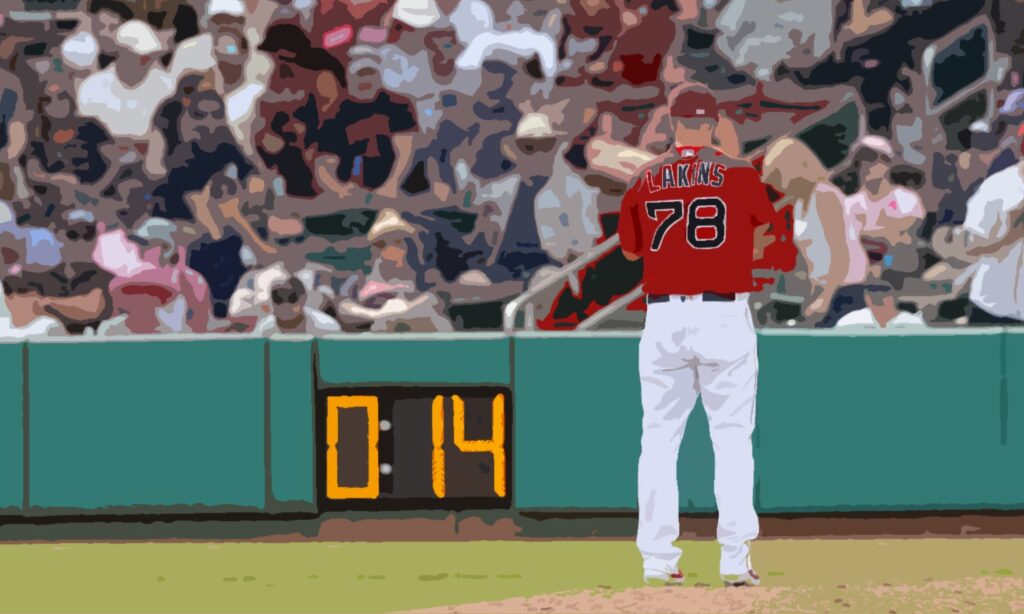Baseball is the only professional sport of the “big 4” in North America that doesn’t use a game clock.
In case you don’t know, the other three sports I’m referring to here are Basketball (NBA), Football (NFL) and Hockey (NHL).
And without a game clock, pitchers and batters can take as much time to prepare for a pitching sequence as they please.
What looks like unhealthy ticks developed by players (especially pitchers) are, in fact, stalling tactics to gain an edge.
I’m talking about sticking the arm up their sleeve, touching their cap, licking their fingers and waving off several pitch recommendations and so on.
Some might argue that the pitchers are using a sticky substance for better grip off the pitch.
While these substances are illegal, the ticks become part of the concealing tactic.
The more accepted reason is that pitchers are recovering in-between pitches and are calculating where to pitch to next, without messing up.
Nonetheless, the sum of these delays caused games to last over three hours on average. That was the MLB seasons between 2012 and 2022.
Things have changed since then and now games have shed 25 minutes from all-time average highs.
How long is an Inning in Baseball?
The average inning in baseball lasts 17 and a half minutes in real time. The inning referred to here is made up of the top and bottom half or 6 outs in total. The average inning is down by two and a half minutes compared to 2022, prior to the addition of the pitching clock.
The pitching clock was one of the measures introduced by MLB to speed up the game.
In short, pitchers have 15 seconds to deliver each pitcher per batter. If a runner is on base, that timer increases to 20 seconds.
Furthermore, pitchers have 30 seconds to regroup for the next batter on deck.
The batter must also adhere to a timer requiring him to be in position for the pitch.
If either player fails to meet the deadline, they will be penalized with a ball (pitcher) or a strike (batter).
How many Outs are in an Inning of Baseball?
As mentioned above, there are 6 outs for every inning in baseball. That is, each team is given three outs per inning at bat.
The inning is divided in the top and bottom half as teams exchange the opportunity to go up to bat.
The top half is reserved for the visiting team, while the bottom half for the home team.
So, while one team is set to bat, the other sends out their fielders to defend against.
As long as the team successfully hits the ball or reaches base without amounting three outs, the inning will go on.
It’s quite possible for innings to drag out more than expected, especially if the offensive team is on a hot streak.
In these particular cases, you’ll witness the team go through the full batting rotation or beyond.
Similarly, an inning can technically last less than six outs. This happens specifically in the game’s 9th inning.
In fact, the game will end after the top of the 9th if the home team is leading the score in runs. That’s because the visiting team ran out of opportunities at bat to even the score or take the lead.
In some cases, the game may proceed to the bottom of the 9th but end abruptly due to a walk off run.
Essentially, a walk off run means that the team scores the go-ahead point, which results in the end of the game.
Again, this is because the opposing team ran out of opportunities at bat.
How many Innings are there?
Your standard baseball game is made up of 9 innings. Each team gets three outs at-bat, per inning.
If the score is tied after 9 innings, the game will continue into extra innings. MLB games cannot end in a tie, so the number of extra innings is, theoretically, limitless.
The reality is that the longest a single game has reached was 26 innings.
Meanwhile, I’ve also highlighted that games can end in less than nine full innings played.
Since the visiting team always plays the top half of each inning, the game can end before reaching the bottom half of the 9th or midway through.
That’s because the home team either is leading in runs or scored the game winning run.
Because of this, there’s no need to continue further if the visiting team has run out of opportunities at-bat.
What is the longest Inning in MLB history?
While the longest game lasted 26 innings, the longest inning is another story.
In fact, the longest inning to date occurred back during a 2004 regular season game between the Detroit Tigers and Texas Rangers.
The game happened on May 8th, 2004 in which the two teams combined for a total of 18 runs during the fifth inning of play.
The total inning time: 68 minutes.
Final Thoughts
Watching baseball growing up, I cannot help but remember it was the least stressful of all the major sports.
This is because no game clock involved.
The length of an inning would only matter if the opposing team was pummeling my team while at bat.
Otherwise, I would only get annoyed when teams would switch out their pitchers.
The delay between bringing in the reliever and the warm can get frustrating.
Panic would only set in if my team was losing heading into the 9th inning. It becomes a “now or never” situation.
If there is anything worse than my team losing, it’s that inevitable feeling when there is one out left in the game.
While miracles do happen, it’s more likely that the game is already over.
Just get me out of my misery.






